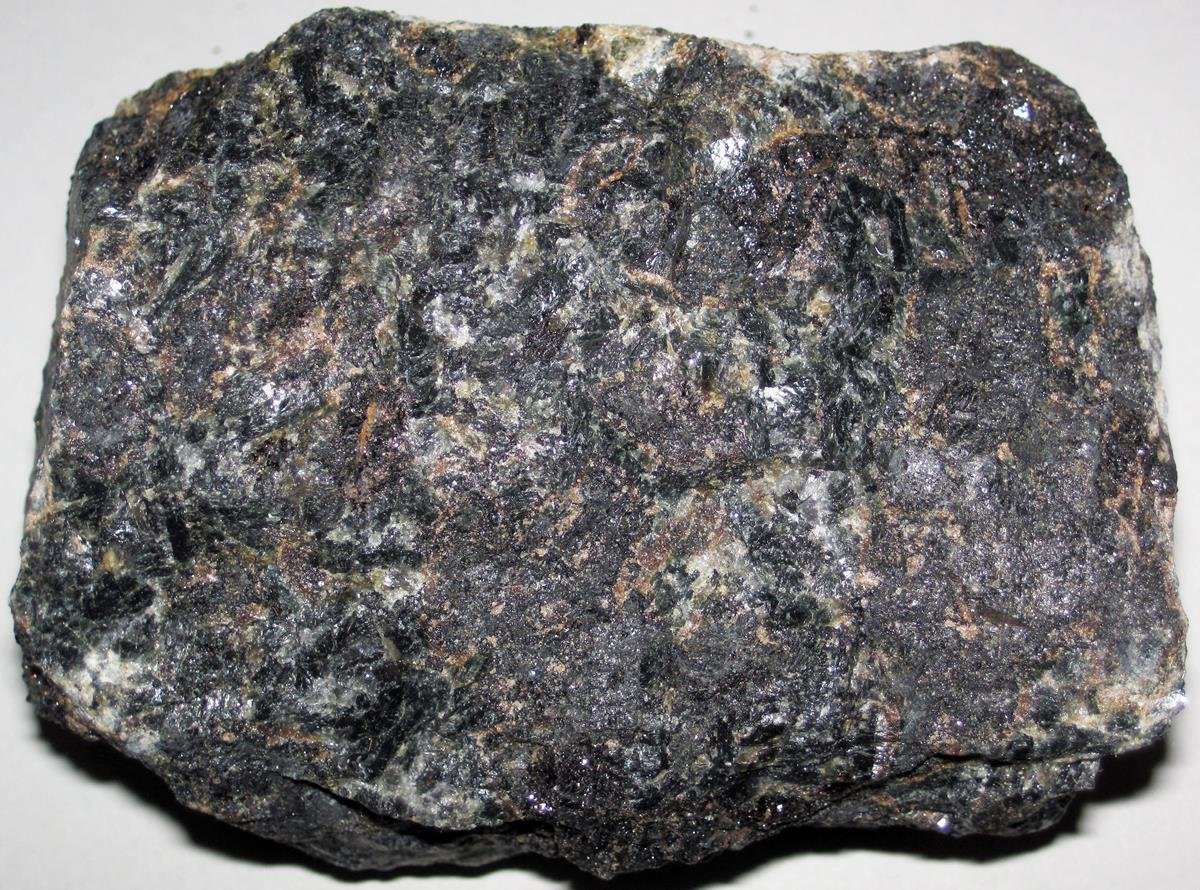Norite is a coarse-grained plutonic rock with mainly calcic plagioclase, orthopyroxene, and a minor amount of other minerals.
Plutonic rocks form deep in the Earth’s crust, where cooling is slow, which gives time for large crystals visible to the naked eye to form.
Let us look at its properties, chemical and mineral composition, formation, and uses.

Description and properties
Norite is a coarse-grained, dark-colored plutonic rock with a Mohs hardness scale of 6-7 and 2.7 to 3.3 g/cm3.
This rock is usually light to dark gray, with lighter and darker grains or a speckled appearance. However, some specimens may have a brown, green, or black coloration.
Norite’s usual color index M is 35–65. A specimen with a color M less than 35 is a leuconorite, while a melanonorite’s color index is between 65 and 90.
In addition to the coarse-grained texture, this rock can have other textures like pegmatitic, poikilitic, or porphyritic.
Lastly, some varieties, known as micronorites, have a medium grain size. These varieties form closer to the earth’s surface, where cooling is a little faster.
Chemical composition
Norite is chemically a basic rock like basalt with 42–52% silica. It is high in iron and magnesium, which are dark-colored elements, and lower in sodium, potassium, aluminum, oxygen, and silicon, which are lighter-colored elements.
Mineral composition
Norite is a mafic rock dominated by calcium-rich plagioclase and magnesium-rich orthopyroxene. It also has a smaller amount of biotite, clinopyroxene, hornblende, and sometimes olivine, cordierite, or alkali feldspar, with quartz, ilmenite, and magnetite being the most common accessory minerals.
The magnesium-rich orthopyroxene in this rock is enstatite or Fe-rich bronzite, while the clinopyroxene present is augite.
According to the QAPF classification of plutonic rocks, norite is defined as a coarse-grained rock with plagioclase accounting for over 90% of the total feldspars and quartz up to 5% of the QAPF content by volume. It doesn’t have feldspathoids.
Clinopyroxene norite rocks have more than 5% clinopyroxene, while monzonorite has a composition between norite and monzonite.
Lastly, gabbronorite has nearly equal amounts of orthopyroxene and clinopyroxene.
Formation
Norite forms when magma cools slowly in magma chambers deep inside the Earth’s crust. Slow cooling gives time for crystals to grow large, forming a coarse-grained texture.
Norite magma is most likely the result of progressive fractionation and crustal contamination. It is also possible for magma of such a composition to form from the mixing of a small amount of granite and a large amount of basaltic magma.
Where are norite rocks found?
Norite rocks primarily occur as part of layered intrusions with other rocks like dunite, gabbro, diorite, harzburgite, anorthosites, and sometimes granites. These rocks can also occur as independent lopoliths or dike swarm intrusions.
Some locations with norite are layered intrusion complexes, like Bushveld in South Africa, Still Water in Montana, USA, and Skaergaard in Greenland. More examples are Sudbury in Canada, Great Dyke in Zimbabwe, and Haddo House Complex in Aberdeenshire, Scotland.
Norite uses
Properties like hardness and durability make norite rocks an excellent choice of dimension stone. Uses include facing, curbing, building, etc. Polished ones can make tiles, window sills, kitchen countertops, pavers, and cemetery markers, among other uses.
When crushed, they make aggregate for road construction and railroad ballast. They are also low in silica, making them perfect for concrete aggregate, and you can use these crushed rocks for landscaping.
Lastly, some norite emplacements have chromite, titanium, platinum, and nickel deposits of economic value. Examples are the Bushveld and Still Water complexes and Egersund, where they are associated with platinum deposits.
Frequently asked questions
Norite is dominated by orthopyroxene, while gabbro is dominated by clinopyroxene. You need a petrological microscope to see these differences since clinopyroxene has a monoclinic structure and orthopyroxene is orthorhombic.
